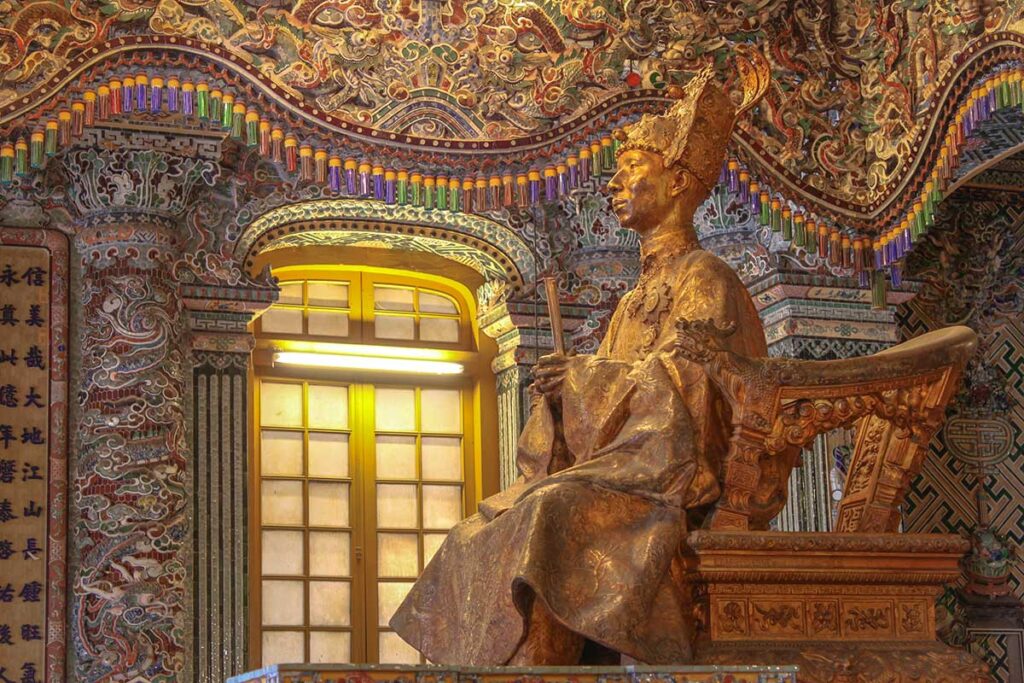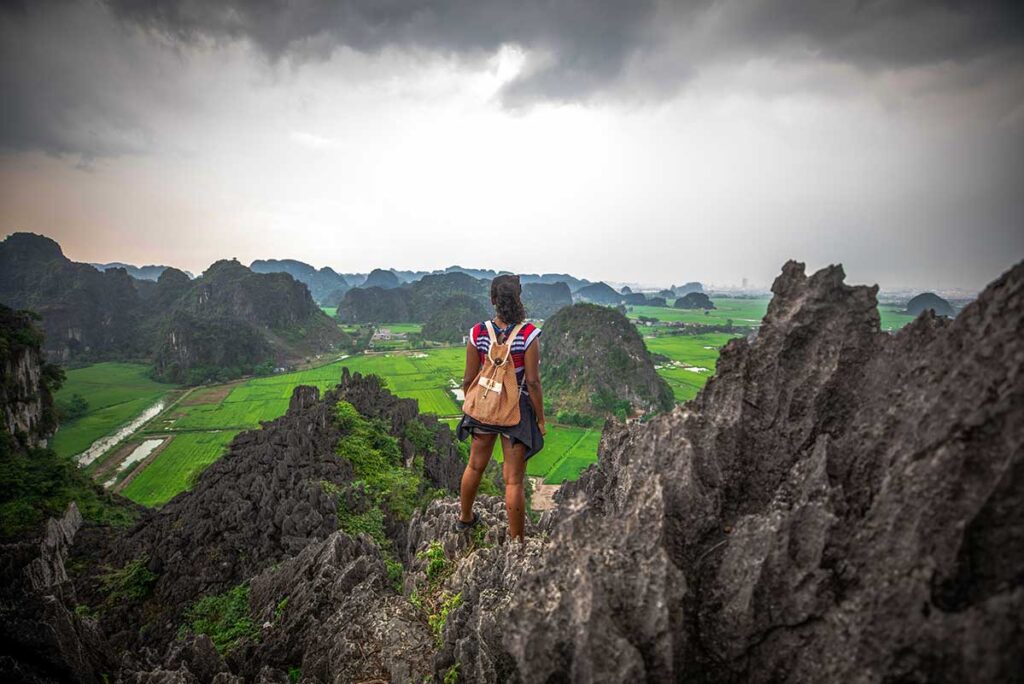Who Was Khai Dinh?
Born Nguyễn Phúc Bửu Đảo in 1885, Khải Định became Vietnam’s 12th Nguyễn emperor in 1916 and ruled until his death in 1925. His reign is best remembered for his dependence on the French colonial authorities, which earned him a reputation among Vietnamese nationalists as a puppet ruler.
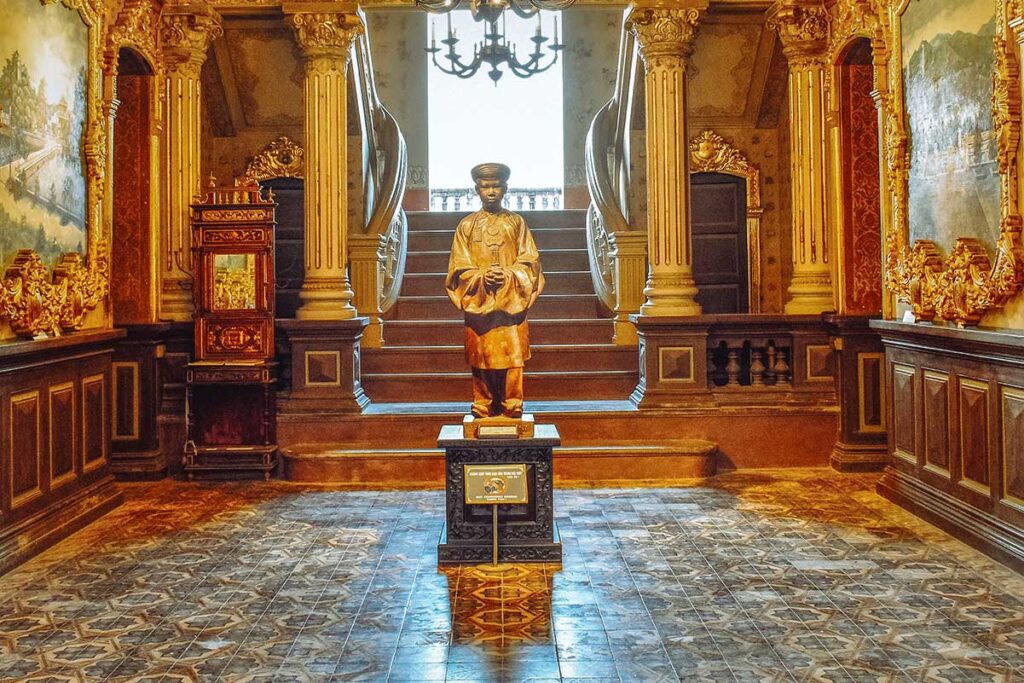
At the same time, he was personally fascinated by Western culture and architecture, introducing European styles into the royal court and commissioning ambitious projects, most notably his ornate tomb outside Hue. This contrast—between a ruler criticized for political weakness and a patron of striking cultural change—makes Khải Định one of the dynasty’s most controversial and visually influential emperors.
Vietnam at the time of Kha Dinh
By the time Khải Định came to the throne in 1916, Vietnam was firmly under French control as part of Indochina. The Nguyễn emperors had been reduced to largely ceremonial roles, their authority overshadowed by colonial administrators who dictated real policy. Khải Định, like the few emperors before him, had little power beyond the palace walls, and his survival on the throne depended heavily on French support.
At the same time, nationalist movements were gaining strength across the country. Secret societies, underground newspapers, and reformist scholars began pushing back against colonial rule, while exiled leaders like Phan Bội Châu called for independence. This rising wave of resistance clashed sharply with Khải Định’s visible cooperation with the French, making his reign deeply unpopular among ordinary Vietnamese. Understanding this backdrop explains why his architectural achievements are admired today, but his political reputation remains clouded by criticism.
Key events in Khai Dinh’s life
Early Life & Rise to the Throne
Khải Định, born Nguyễn Phúc Bửu Đảo in 1885, grew up during a period when French influence over Vietnam was already dominant. His education combined elements of traditional Confucian training with exposure to Western ideas, reflecting the cultural shifts of the time. In 1916, he became emperor after his cousin, Emperor Duy Tân, was deposed and exiled for supporting an anti-French uprising. From the start, Khải Định’s position was inseparable from colonial backing.
A Puppet of the French
Throughout his reign, Khải Định depended heavily on French support, which quickly made him unpopular among Vietnamese nationalists. His most criticized act was raising taxes on the population to finance his grand tomb project. This decision, combined with his open cooperation with colonial administrators, reinforced the image of him as a “puppet emperor” serving foreign interests rather than his own people.
Western Influence & Modernization
Unlike earlier Nguyễn emperors, Khải Định embraced Western influence in everyday life and royal projects. He introduced European clothing and architecture into the court, breaking from strict Confucian traditions. He also sent his son and heir, Crown Prince Vĩnh Thụy (later Emperor Bảo Đại), to France for education—further cementing the dynasty’s ties to the colonial power and shaping the character of Vietnam’s last emperor.
Construction of Khai Đinh Tomb
In 1920, Khải Định commissioned his tomb on a hillside outside Hue. Unlike the serene, traditional designs of earlier emperors, this complex combined Vietnamese architecture with Baroque, Gothic, and even Art Deco influences. The use of concrete, stained glass, and elaborate mosaics made it stand out as the most extravagant of Hue’s imperial tombs. While visually striking, its construction was funded through increased taxation, deepening resentment among his subjects.
Decline & Death
Khải Định’s health declined in the early 1920s, and he traveled to France seeking medical treatment. He died in 1925 at the age of just 40, leaving behind a controversial reputation and an unfinished legacy. His son, Bảo Đại, succeeded him and would become Vietnam’s final emperor, ruling through the last years of colonialism until his abdication in 1945.
Emperor Khai Dinh in Vietnam today
Tomb of Khai Dinh (Hue)
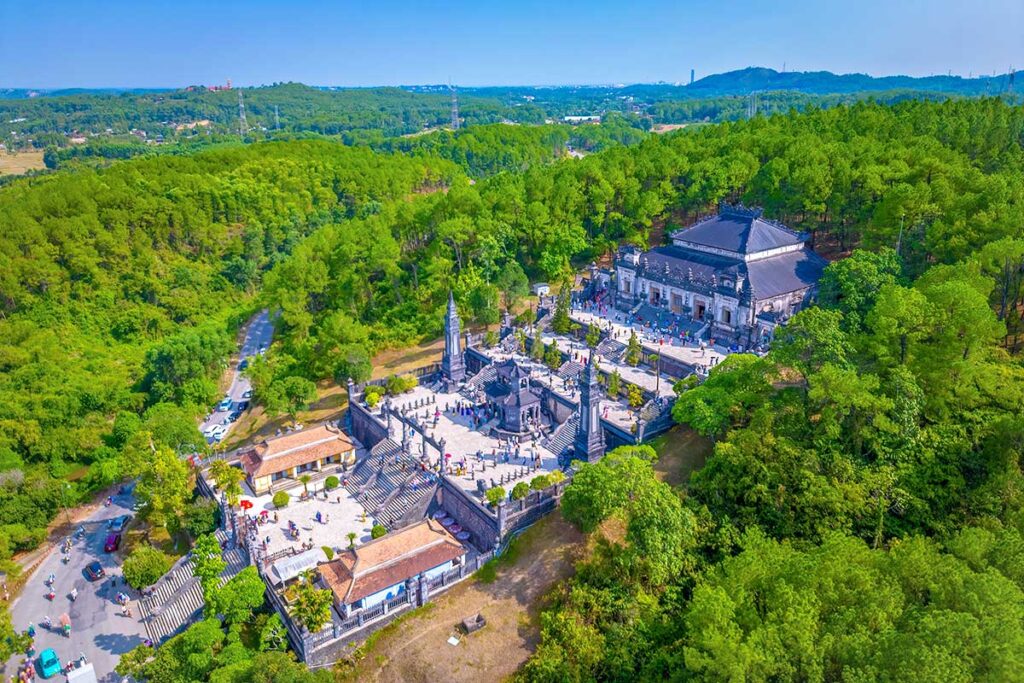
The most important site connected to Khải Định is his tomb, located on the slopes of Châu Chữ Mountain, about 10 km outside Hue. Visitors climb a dramatic series of staircases before reaching the ornate courtyards and halls, where Vietnamese design is fused with European Baroque, Gothic, and even early modernist styles. Inside, the walls are covered with intricate glass and porcelain mosaics, and the emperor’s gilt bronze statue sits beneath a richly decorated ceiling. It is visually dazzling and often considered the most spectacular of Hue’s royal tombs. At the same time, the heavy taxes levied to build it left a bitter legacy, making the site as controversial as it is beautiful.
Hue Imperial City
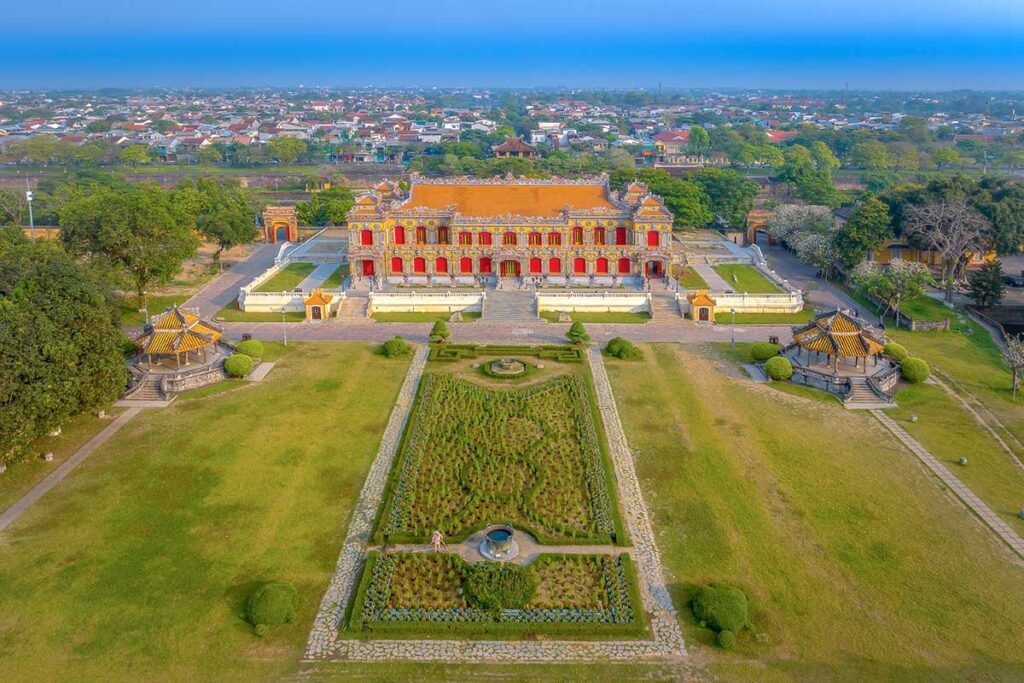
Inside the Imperial City, Khải Định’s main addition was Kiến Trung Palace, a residence built in a distinctly European style with French furniture and Western decorative details. While most of it was destroyed during the wars of the 20th century, restoration efforts are underway, giving visitors an impression of how boldly he reshaped the traditional royal compound with modern influences. For travelers, it offers a glimpse of how the Nguyễn dynasty’s final emperors were caught between tradition and colonial modernity.
An Dinh Palace
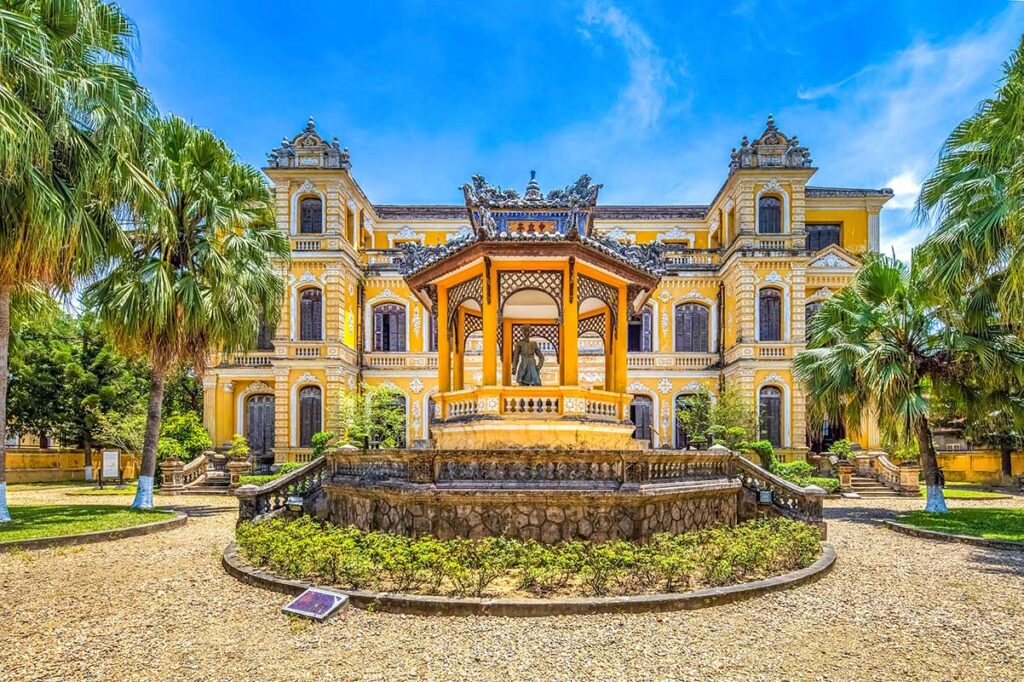
Just a short distance from the Citadel, along the An Cuu River, stands An Định Palace, Khải Định’s private residence. Built in 1917, it combines Baroque and Art Deco elements with Vietnamese motifs, creating a striking mix that feels unlike any other royal building in Hue. The interior murals and restored halls give a sense of his fascination with Western aesthetics. It’s often overlooked by visitors focused on the tombs, but for those interested in architecture and history, An Định Palace provides a broader perspective on his reign and lifestyle.
Connection to Bao Dai
Khải Định’s most enduring legacy beyond architecture was fathering Crown Prince Vĩnh Thụy, who became Emperor Bảo Đại in 1926. Bảo Đại was Vietnam’s last emperor, and his rule marked the final chapter of the Nguyễn dynasty. Visiting Khải Định’s sites today also connects travelers to this larger story of Vietnam’s monarchy and its eventual collapse under colonial and revolutionary pressure.
Modern Memory
Khải Định’s memory in modern Vietnam is mixed. While his tomb and palaces are celebrated as cultural landmarks, his political image is less admired because of his close collaboration with the French and the unpopular taxes he imposed. Streets and schools occasionally bear his name, but he is often remembered more for his architectural legacy than for his leadership. For travelers, this combination of beauty and controversy makes exploring his sites in Hue especially meaningful.
Other famous emperors of Vietnam
Khải Định’s reign was brief and controversial, but he was part of a longer line of rulers whose decisions shaped Vietnam’s history in very different ways. Knowing a few of these emperors helps place his legacy into perspective.
- Gia Long (reigned 1802–1820) – Founder of the Nguyễn dynasty who reunified Vietnam after centuries of division and established Hue as the imperial capital.
- Minh Mạng (reigned 1820–1841) – Known as an empire builder and strict Confucian ruler, he strengthened central control and expanded the dynasty’s reach.
- Tự Đức (reigned 1847–1883) – The longest reigning Nguyễn emperor, remembered as a scholarly poet but also criticized for conservative policies that left Vietnam vulnerable to colonial conquest.
- Bảo Đại (reigned 1926–1945) – The last emperor of Vietnam, who abdicated in 1945 as Hồ Chí Minh declared independence, bringing an end to the monarchy.
